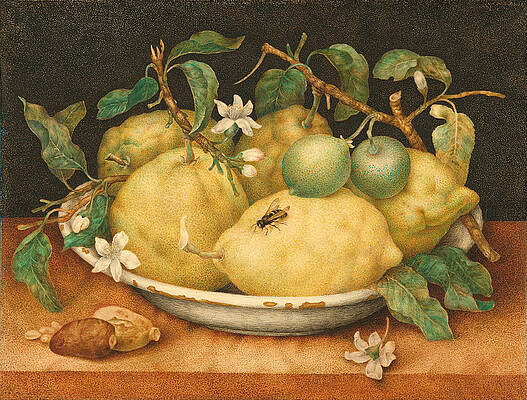Giovanna Garzoni
Still Life with Pears and a butterfly
Still life with pumpkin flowers and vine leaves
Still Life with Peaches and carob
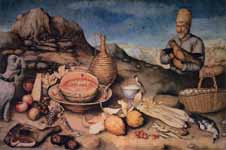
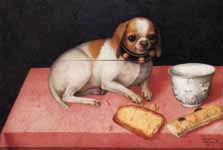
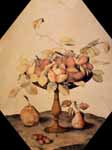
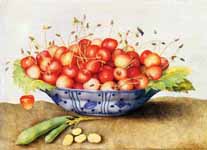
Chinese Porcelain Plate with Cherries
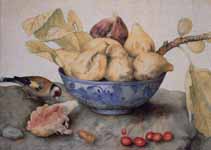
China Bowl with Figs, a Bird, and Cherries
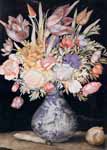
Chinese Vase with Flowers, a Fig, and a Bean
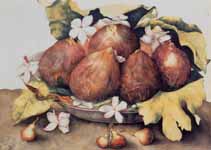
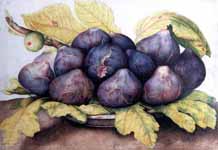
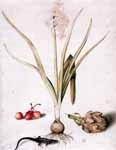
Hyacinth with Four Cherries, a Lizard, and an Artichoke
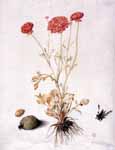
Ranunculus with Two Almonds and a Hymenopteran
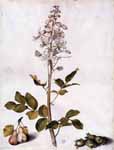
Branch of Dittany with Four Hazelnuts and Two Pears
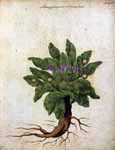
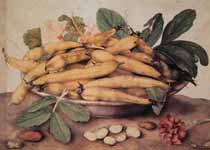

Portrait of Carlo Emanuele I, Duke of Savoy
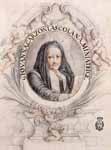
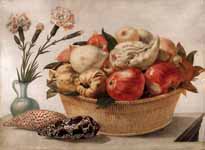
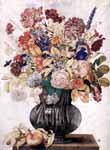
Vase with Flowers, a Peach and a Butterfly
Giovanna Garzoni (1600-1670) was an Italian painter who was prominent in Europe during the Baroque period. Garzoni started her career painting religious, mythological, and allegorical subjects but became famous for her works with tempera and watercolors of botanical subjects.[1] The artist rose to prominence due to her precision and balance with space and scientific realism of her subjects.[2] Garzoni was often called the Chaste Giovanna due to her vow to remain a virgin. Garzoni is also notable for being one the few women who opted to travel throughout Europe and receive an education during the 17th century instead of settling down and starting a family.[3] Scholars have speculated Garzoni may have been influenced by fellow botanical painter Jacopo Ligozzi[4] although details about Garzoni's training are widely unknown.
Early life
Giovanna Garzoni was born in 1600 in Ascoli Piceno in the Marche district of Italy to Giacomo Garzoni and Isabetta Gaia.[5] Both of Garzoni's parents were of Venetian origin and are believed to have come from a long line of Venetian painters but this item is often disputed.[6] Garzoni's grandfather Nicola and uncle Vincenzo from her mother’s side were both goldsmiths while her other uncle, Pietro Gaia, was a painter who studied at the school of Palma the Younger.[7] Historians have widely speculated that Garzoni started off her career as an apprentice under her uncle sometime before 1615. Garzoni also had a brother, Mattio whom she would travel with throughout her career as an artist.[8]
Career
After residing in Rome for the first 15 years of her life, in 1616 Garzoni accepted a commission from chemist Giovanni Vorvino of Rome to paint a herbarium.[9] Four years later in 1620 Garzoni arrived into Venice and painted Saint Andrew for the Venetian Church of the Ospedale delgi Incurabili. Garzoni stayed in Venice for a few more years and during that time attended the Calligraphy school of Giacomo Rogni. Shortly after her studies, Garzoni produced a book of cursive characters called the Libro de'caratteri Cancellereschi Corsivi.[10]
After receiving an education, in 1630 Garzoni along with her brother Mattio, left Venice for Naples where she worked for the Spanish viceroy, The Duke of Alacala. Garzoni remained in Naples for one year until she moved to Rome in 1631. Garzoni’s stay in Rome was short lived however, due to Christina of France’s persistent efforts to have the artist come to Turin to serve as the miniaturist for the Turinese court.[11] Garzoni reached Turin in 1632 and lived there until 1637. After staying in Turin, Garzoni became familiarized with fellow artists Fede Galizia and Panfilo Nuvolone.[12] A few years later in 1640, Garzoni arrived in Paris and stayed there until 1642 when she went to Rome. Garzoni traveled back and forth from Rome to Florence until 1651 where her primary client became was the prominent Medici Family,particularly Grand Duke Ferdinando II, Grand Duchess Victoria, and Gardinal Giovan Carlo.[13]
After serving the Medici Court,Garzoni decided to settle in Rome in 1651 where she worked for the Florentine Court.[14] As well as painting, Garzoni attended the Accademia di San Luca meetings, a program aimed at educating, socializing, and professionalizing painters, architects and sculptors of Rome.[15] It is noted by several historians that Garzoni’s pieces were so well received by the public; she was able to ask any price for her paintings.[16]
Notable Artistic Works and Clients
Plate with White Beans:
Plate with White Beans was one of the many pieces the Medici Family commissioned Garzoni to paint. The piece depicts a dish containing ripe beans and has been noted for the amount of detail the artist put into the piece, even marking points of decay on the beans. The painting was created some time between 1650-1662 and is now located in Florence at the Galleria Palatina.[17]
Cherries on a Plate, Broad Beans, and Bumblebee:
The painting is another example of Garzoni’s many tempera pieces. Garzoni created this piece around 1665 and dedicated it to the prominent Medici family of Florence. The piece is now located in Florence at the Galleria Palatina.[18]
Portrait of Carlo Emanuele I, Duke of Savory:
Thise tempera piece on vellum depicts one of the two portraits created by Garzoni of one of the two dukes of Savory, Carlo Emanuele I, the other being of Emanuele Filiberto. The piece was created between 1623-1637 when Garzoni was invited to work for the court of Turin by Christina of France in 1632.The painting is now located in Palazzo Reale, Turin and was last restored in 1995.[19]
Still Life with a Basket of Fruit, a Vase with Carnations and Shells on a Table:
This gouache on vellum piece is one of the 20 still-life miniatures that Garzoni produced for the Medici family from the years 1650-1662. The piece depicts carnations, conch shells, as well as a basket of fruit. Due to her work for the Medici Court, Garzoni became a favorite within the Florentine court for her depictions of nature and botanical subjects. The piece is now located in the Wallace and Wilhelmina Holladay Collection in Washington, DC.[20]
Plate of Figs:
The year of creation varies from 1661 to 1662. The painting is believed to be part of a 20-piece collection on vellum by Garzoni that all depict miniatures of fruit. There have been several sightings of the piece being reproduced for Garzoni often duplicated her pieces for various clients. The piece is part of the Graham Arader III Collection in New York.[21]
Personal life
It is believed by historians that Garzoni never married but several others have claimed the artist was once married to Venetian portrait painter Tiberio Tinelli in 1622.[22] However the marriage was short lived due to Garzoni’s vow of chastity and as a result Tinelli and Garzoni separated in 1624.[23] Others have also suggested that the reason for the split was due to the belief that Tinelli practiced magic. This resulted in Garzoni’s father Giacomo to suspecting that his son-in-law was practicing witchcraft and encouraging his daughter to end the marriage.[24] Garzoni’s marriage to Tinelli was ended by annulment rather than divorce because they two never consummated their marriage.[25] This was the only way to end a marriage in an era when divorce was not condoned due to the belief that divorce would ruin a man's honor.[26]
Death
Due to her ailing health, prior to her death, in 1666, Garzoni devised a will that left her estate to the Church of Santa Martina, the church of the Accademia di San Luca on the basis that she would be buried in the church. Garzoni died in Rome in February of 1670 at the age of 70.[27] Today, Garzoni’s tomb remains at the Church of Santa Martina but it was not interred there until 1698, nearly 29 years after her death. Along with her tomb, a portrait of Giovanna Garzoni conducted by Roman painter Giuseppe Ghezzi is also located at the Accademia.[28]
Notes
Jordi Vigué. Great Women Masters of Art. (New York: Watson-Guptill, 2003), 77.
Sheila McTighe. “Foods and the Body in Italian Genre Paintings, about 1580: Campi,Passarotti, Carracci”. The Art Bulletin, College Art Association 86 (2004):301-323,accessed October 23, 2014, doi 10.2307/3177419.
Jane Fortune, and Linda Falcone.Invisible Women. (Florence: The Florentine Press, 2010), 101.
“Artists: Giovanna Garzoni”. The J. Paul Getty Museum. Accessed October 22, 2014. http://www.getty.edu/art/gettyguide/artMakerDetails?maker=21178.
Jordi Vigué. Great Women Masters of Art. (New York: Watson-Guptill, 2003), 77.
Jordi Vigué. Great Women Masters of Art. (New York: Watson-Guptill, 2003), 77.
Carole Collier Frick, Stefania Biancani, and Elizabeth S. G. Nicholson. Italian Women Artists: from Renaissance to Baroque. (Milano: Skira, 2007), 220.
Carole Collier Frick, Stefania Biancani, and Elizabeth S. G. Nicholson. Italian Women Artists: from Renaissance to Baroque. (Milano: Skira, 2007), 220-21.
Jordi Vigué. Great Women Masters of Art. (New York: Watson-Guptill, 2003), 77.
Carole Collier Frick, Stefania Biancani, and Elizabeth S. G. Nicholson. Italian Women Artists: from Renaissance to Baroque. (Milano: Skira, 2007), 220.
Carole Collier Frick, Stefania Biancani, and Elizabeth S. G. Nicholson. Italian Women Artists: from Renaissance to Baroque. (Milano: Skira, 2007), 221.
Carole Collier Frick, Stefania Biancani, and Elizabeth S. G. Nicholson. Italian Women Artists: from Renaissance to Baroque. (Milano: Skira, 2007), 221.
Carole Collier Frick, StefaniaBiancani, and Elizabeth S. G. Nicholson. Italian Women Artists: from Renaissance to Baroque. (Milano: Skira, 2007), 221.
Carole Collier Frick, StefaniaBiancani, and Elizabeth S. G. Nicholson. Italian Women Artists: from Renaissance to Baroque. (Milano: Skira, 2007), 221.
“The History of the Accademia di San Luca, c. 1590-1635: Archived from the Archivio di Stato di Roma”. National Gallery of Art. Accessed November 25, 2014. http://www.nga.gov/casva/accademia/intro.shtm.
“The Flowering of Florence: Botanical Art for the Medici”. National Gallery of Art. Accessed October 22, 2014. http://www.nga.gov/exhibitions/flowerartist.htm.
Jordi Vigué. Great Women Masters of Art. (New York: Watson-Guptill, 2003), 79.
Jodi Vigué. Great Women Masters of Art. (New York: Watson-Guptill, 2003), 80.
Carole Collier Frick, Stefania Biancani, and Elizabeth S. G. Nicholson. Italian Women Artists: from Renaissance to Baroque. (Milano: Skira, 2007), 222.
Carole Collier Frick, Stefania Biancani, and Elizabeth S. G. Nicholson. Italian Women Artists: from Renaissance to Baroque. (Milano: Skira, 2007), 238.
Carole Collier Frick, Stefania Biancani, and Elizabeth S. G. Nicholson. Italian Women Artists: from Renaissance to Baroque. (Milano: Skira, 2007), 228.
Carole Collier Frick, Stefania Biancani, and Elizabeth S. G. Nicholson. Italian Women Artists: from Renaissance to Baroque. (Milano: Skira, 2007), 220.
Carole Collier Frick, Stefania Biancani, and Elizabeth S. G. Nicholson. Italian Women Artists: from Renaissance to Baroque. (Milano: Skira, 2007), 220.
Jane Fortune and Linda Falcone. Invisible Women. (Florence: The Florentine Press, 2010), 101.
Joanne M. Ferraro. Marriage Wars in Late Renaissance Venice. (New York: Oxford University Press, 2001), 29.
Joanne M. Ferraro. Marriage Wars in Late Renaissance Venice. (New York: Oxford University Press, 2001), 138.
Carole Collier Frick, Stefania Biancani, and Elizabeth S. G. Nicholson. Italian Women Artists: from Renaissance to Baroque. (Milano: Skira, 2007), 221.
Jane Fortune and Linda Falcone. Invisible Women. (Florence: The Florentine Press, 2010), 103.
References/Bibliography
1.“Artists: Giovanna Garzoni”. The J. Paul Getty Museum. Accessed October 22, 2014. http://www.getty.edu/art/gettyguide/artMakerDetails?maker=21178.
2. Ferraro, Joanne M. Marriage Wars in Late Renaissance Venice. (New York: Oxford UniversityPress, 2001).
3.Fortune, Jane, and Linda Falcone. Invisible Women. (Florence: The Florentine Press, 2010).
4.Frick, Carole Collier, StefaniaBiancani, and Elizabeth S. G. Nicholson. Italian Women Artists: from Renaissance to Baroque. (Milano: Skira, 2007).
5.McTighe, Sheila. “Foods and the Body in Italian Genre Paintings, about 1580: Campi, Passarotti, Carracci”. The Art Bulletin, College Art Association 86 (2004):301-323, accessed October 23, 2014, doi 10.2307/3177419.
6.“The Flowering of Florence: Botanical Art for the Medici”. National Gallery of Art. AccessedOctober 22, 2014. http://www.nga.gov/exhibitions/flowerartist.htm.
7. “The History of the Accademia di San Luca, c. 1590-1635: Archived from the Archivio di Stato di Roma”. National Gallery of Art.Accessed November 25, 2014. http:// www.nga.gov/casva/accademia/intro.shtm.
8. Vigué, Jordi. Great Women Masters of Art. (New York: Watson-Guptill, 2003).
----
Fine Art Prints | Greeting Cards | Phone Cases | Lifestyle | Face Masks | Men's , Women' Apparel | Home Decor | jigsaw puzzles | Notebooks | Tapestries | ...
----
Artist
A - B - C - D - E - F - G - H - I - J - K - L - M -
N - O - P - Q - R - S - T - U - V - W - X - Y - Z
Retrieved from "http://en.wikipedia.org/"
All text is available under the terms of the GNU Free Documentation License


